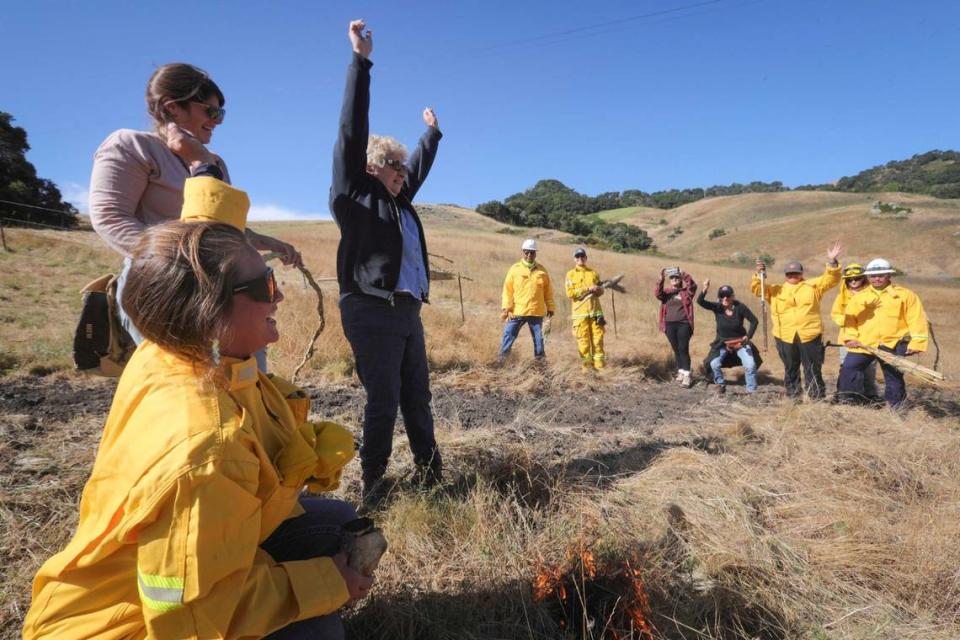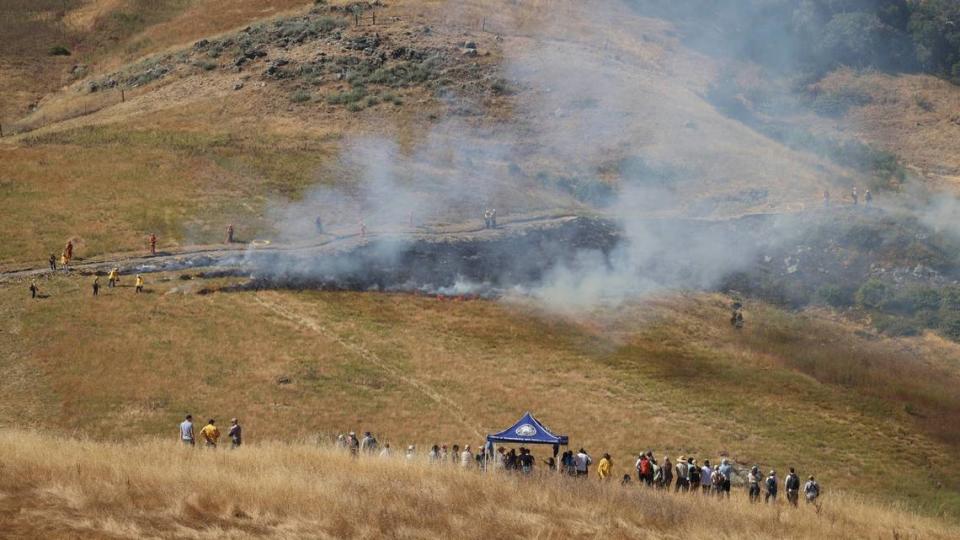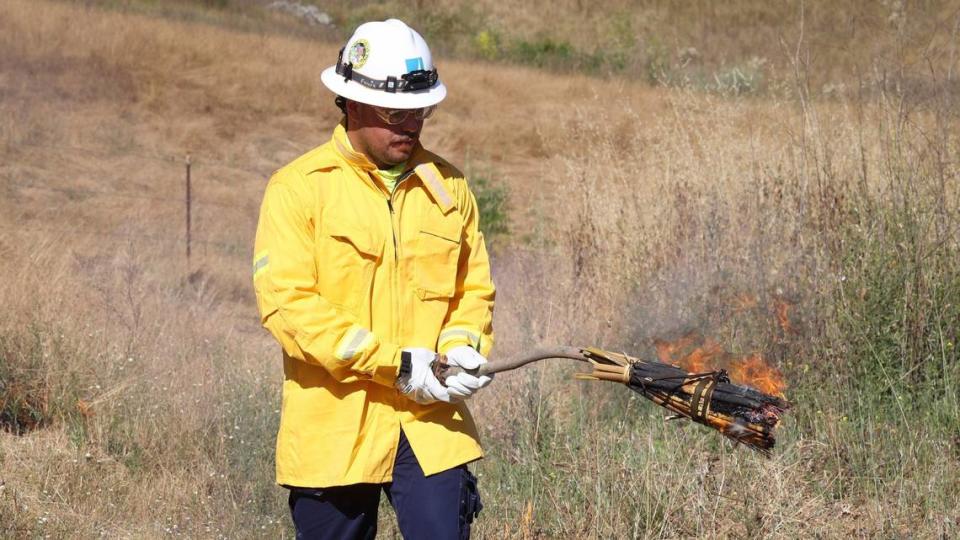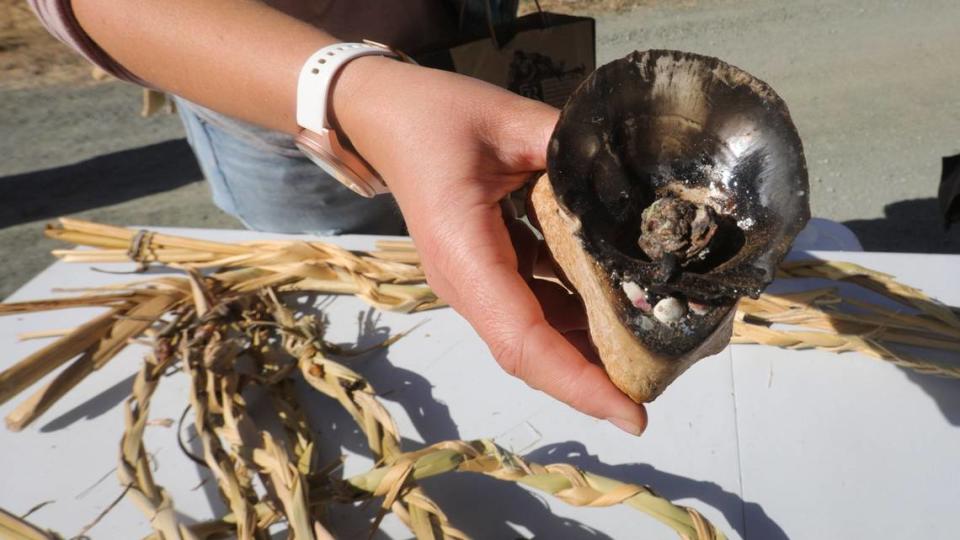On a warm, windless morning, members of the yak titʸu titʸu yak tiłhini Northern Chumash Tribe carried a candle-like flame up a hill in San Luis Obispo.
Slowly, ytt Tribal Chair Mona Olivas Tucker dipped a rope of braided, dried tule in the flame, then lowered the fire onto a mound of parched grass.
As the fire popped and crackled to life, the assembled ytt Tribe cheered — celebrating the first time in generations they could return tinɨtʸu, or “good fire,” to their ancestral land.
“It really felt like coming home,” cultural burn practitioner Becca Lucas told The Tribune during the event Tuesday morning, which took place on 15 acres of the Johnson Ranch Open Space in San Luis Obispo.
Cal Fire, San Luis Obispo City Fire and other SLO city departments helped coordinate and implement the burn.

For months, the ytt Tribe and the city prepared the land for the burn — harvesting native purple needlegrass seeds, collecting burn materials and hacking away brush to prevent the fire from spreading too fast.
The burn will remove invasive plants and reduce wildfire risk, while revitalizing native plants and restoring a cultural practice, Lucas said.
“Our families are the stewards of this land,” ytt Tribe cultural burn practitioner Kelsey Shaffer told The Tribune. “We can help heal the land, and the land heals us in the process.”


SLO partners with ytt Tribe for cultural burn
Traditionally, the ytt Tribe burned land periodically to return nutrients to the soil and promote healthy plant growth.
These fires were smaller and cooler than the massive wildfires that have charred California during the past decade, Shaffer said.
“They were more manageable and just less destructive,” she said. “A totally different kind of fire that doesn’t scorch the earth or the seed bank.”
Other Indigenous peoples in California also used fire as a land management tool.
Between prescribed burns and lightning strikes, 5 million to 13 million acres of land was believed to have burned annually in prehistoric California, according to a 1992 report by ecologists Robert Martin and David Sapsis.
In 2020, during California’s worst fire year on record, 4.3 million acres burned in the state, Cal Fire reported — far less than prehistoric fire levels.
“It is pretty eye-opening for what this land actually needs and what it’s not getting,” Lucas said.


As settlers poured into California during the Gold Rush, the California State Legislature passed laws to block Indigenous peoples from practicing their traditions — such as banning intentional burns in 1850 with the Act for the Government and Protection of Indians.
Though California does now allow prescribed burns as a means of wildfire management, without access to the land, the ytt Tribe has had no way to conduct cultural burns for generations.
“There are so many traditional practices we could not practice on our own without permission to access land, without permission from someone to do something,” Shaffer said.
About two years ago, San Luis Obispo updated its Climate Adaption Safety Element to include the ytt Tribe as a consultant for vegetation management, Lucas said.
The city, Cal Fire and the ytt Tribe started planning the cultural burn at the start of this year. The ytt Tribe led the planning efforts, while the city and Cal Fire provided additional safety support.
“Tribes have to be consulted for a variety of reasons for a variety of things, but don’t always get listened to,” Lucas said. “To be in a position where they’re like — you are the experts on your homeland, on this practice, on what you’re doing, we are listening to you, we are trusting you, we are respecting you — is huge.”
Moving forward, city staff hope to learn from the ytt Tribe and apply their traditional ecological knowledge to the management of other open spaces, biologist Freddy Otte told The Tribune.


How did ytt Tribe, SLO city conduct cultural burn?
While Cal Fire uses gasoline and diesel to fuel its prescribed burns, the ytt Tribe ignited their fire with natural materials collected at the Johnson Ranch Open Space.
“If we want things to grow back healthy, we don’t want to poison the soil,” Shaffer said, noting that when they ran out of natural materials Tuesday, they did use a small amount of gasoline and diesel to help finish the burn.
Their primary burning tool, however, was a fire torch, which is an oak branch topped with dried grass and tule leaves, pine needles, lichen and moss. At the center of the torch were pine cones doused in sap and rolled in grass.


Purple needlegrass and other native bunch grasses evolved to withstand fire, as they have deep root systems that survive low-intensity burns, Shaffer said. Invasive annual grasses, however, die each summer.
A low-intensity, prescribed fire will burn away the non-native grass seeds, while the dormant, native plants will survive the fire and bloom again in the fall.
After this burn, the ytt Tribe raked the ash into the soil. If the ash is left on the ground, it traps heat in the soil — baking the seed banks and preventing the plants from growing back, Shaffer said. Raking the soil releases some of the heat and massages nutrients from the burned plants back into the land.
The ytt Tribe sprinkled purple needlegrass seeds on the burn scar to encourage their growth, too.
Unlike Cal Fire, the agency that usually performs prescribed burns, the ytt Tribe will continue to monitor this 15-acre plot of land to evaluate how each plant reacted to the burn.
“We don’t just walk away afterwards and say, ‘Well, good luck, little seedlings,’” Shaffer said.
If the invasive grasses return, the ytt Tribe will burn the land again.
“We have to be flexible and listen to what the land is saying,” Shaffer said. “Watch it — what is it showing us that it needs?”


Shaffer noted that the ytt Tribe lives by the phrase, “qhinɨwana wa qtoʔ,” which means, “to know is to be responsible.” They consider themselves stewards responsible for the health of the land, she said.
“We are not separate from nature, we are a part of nature, and we have a great big responsibility,” Shaffer said. “All humans, we are called to be stewards, we are called to know better. We should know how our actions impact our land and our water and the ecosystem and the habitat.”


The more often the ytt Tribe treats the land with prescribed fire, the more manageable the burns will become, she added.
“We will have hotter fire in the beginning,” Shaffer said. “But over time and with consistent fire, it’s not going to burn so hot, it’s not going to burn so high, it’s not going to burn so far and wide, because the land will be used to it. It will be happy with its fire.”
In the fall, the ytt Tribe hopes to burn underneath an oak tree canopy on the same property.
Oak seedlings don’t like shade, so it’s important to use fire to clear brush underneath the trees so the seedlings get enough sunlight to grow, Lucas said.
Lucas pointed to an area by the creek where coastal sage brush mingled with poison oak and delicate, pale pink flowers called morning glories. Stands of purple needlegrass swayed in the breeze nearby.
“Here’s what we want: all of the things just growing together,” Lucas said. “These will become healthier over time.”


Source Agencies


